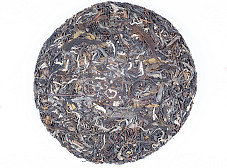
Sheng Puerh
In tea factories, Mao Cha from different sources is often mixed and then steamed and pressed into various cake, brick or tablet shapes, in which the tea is then gradually dried, fermented and aged. Maturing takes a very long time, preferably several decades. The maturation process itself is a combination of oxidation, as we know it for example in black teas, and microbial fermentation assisted by bacteria, moulds (most commonly Aspergillus) and yeasts. The cocktail of these living organisms in the tea varies from region to region, and so the resulting product of long-term maturation can take many forms.
More...Of course, the place where the puerhs are ripened also has a great influence on this process. In particular, temperature and humidity. Apart from Yunnan itself, some of the most famous areas where puerhs are ripened are Hong Kong, Malaysia and Taiwan. Originally, puerh teas were intended exclusively for post-ripening and were only really drunk many years after they were produced. In that time, the tea completely changes its character from essentially green leaf, light clear infusion and a sharp, sharp taste to a very dark tea with a delicate, deep, smooth, yet dense flavour.




